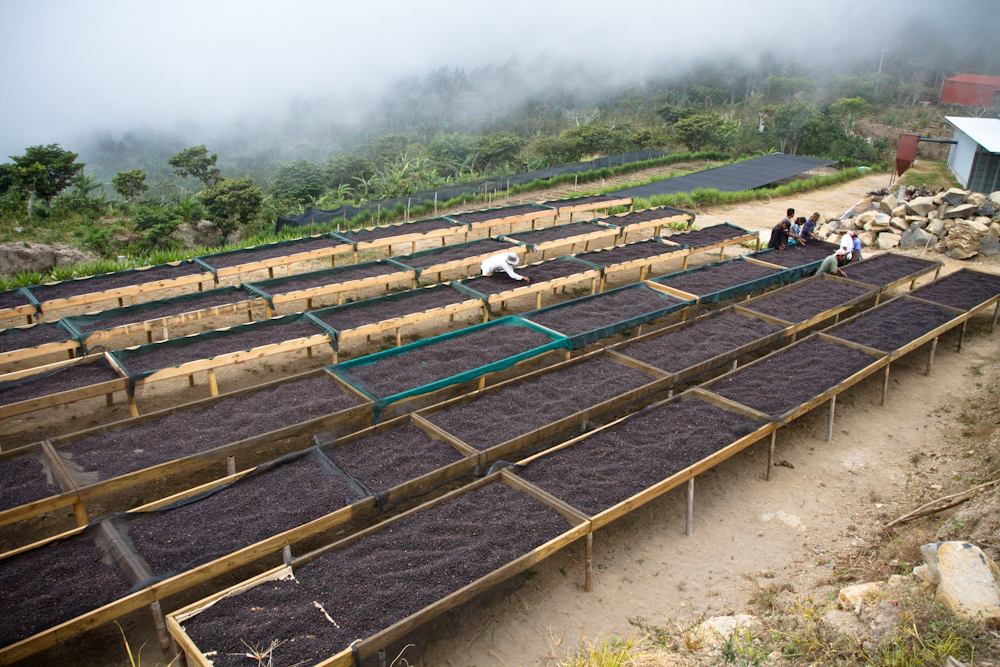What are the coffee producing areas of Ethiopian coffee forest? Harald coffee producing area of Ethiopia
Professional coffee knowledge exchange More coffee bean information Please pay attention to coffee workshop (Weixin Official Accounts cafe_style)
What are the coffee forests of Ethiopia? Ethiopian coffee producing Harar coffee beans flavor and taste description?
Ethiopia's coffee-producing area is divided into two walls by the Great Rift Valley, east and west, each evolving separately.
Ethiopia
West: Lake Tana, Gimbi, Nekemti,
Iruba, Limu and Jimma of the Kafa Forest
Bonga, Teppi, Bebeka.
East: Harar, Sidamo, Yirgacheffe
Lord.
Due to the obstruction of the Great Rift Valley, the coffee beans in the two halves are different in type.
The eastern half of the Hara variety → beans thin and pointed, there are long and short body difference;
West half of the original forest varieties complex, northwest of Iruba Bai, Tana Lake
And the beans are stronger than gold.
Coffee farmers in the Harrah highlands in the east and the Kafa forest in the southwest,
There is a bright plot, and eastern farmers claim that Arabica originated in the Harrah Highlands
Instead of the Kafa Forest in the southwest.
Kafa Forest: Kimma, Tibi and Bebeka.
The disease resistance is higher, but the flavor is inferior to the eastern half.
Strong in the west, weak in the east, elegant in the east and vulgar in the west
In 1975, 227 resistant varieties were found in Kafa forest, which was obviously higher than that in eastern part.
The flavor is that the eastern Hara, Yega Shefi and Sidama win.
maximum diversity of cultivation system
Forest Coffee (Forest Coffee)
Wild coffee trees in virgin forests. Protected by the government, there are special personnel to harvest.
The total yield is only 5- 10%.
Semi-forest coffee
Semi-wild coffee. Farmers come into the forest regularly to prune shade trees or coffee branches.
Increase transparency and fruit yield. Total production is 35%.
Garden Coffee
A small farmer who grows his own crops mixed with other cash crops, mostly in elephant legs.
Below. Total production is 50%.
Plantation coffee
State or private development of land, similar to Central and South America's entrepreneurial and scientific management.
The total output is only 5- 10%.
Yirgacheffe
Altitude 1,800--2,000 m| Garden coffee system
Yejia Xuefei exploded red international:
Treatment method: washing mainly
After 1970, washed yega sherry unique floral and citrus flavor burst red international,
It is known as "Yega Sherffi Flavor".
In 2003, a chemist named "Dr. Illyley"(deceased), presented at the American Fine Arts Association
During the speech, it was pointed out that certain aromatic ingredients of Yega Shefi are in Chanel No. 5 perfume
This aroma is also found in Darjeeling tea, known as Darjeeling black tea and champagne.
sun
But beginning in 2006, solarization treatments blew the horn of counterattack at the "Gold Co-op Coffee Contest"
(Gold Cooperative Coffee Competition) Sun-dried beans, pain-killed washed beans, top three
The high scores are all wrapped up in sun beans.
Coffee trader "Adullah Baghi" in the highest elevation of the Yega Valley (MistValley) to
Small farmers acquire specific varieties of ripe extra red fruit and concentrate them in Idido, where they operate.
Sunlight home factory processing. Strict quality control process of yega-sherry sun-dried beans, in the category of fine coffee
It has repeatedly blossomed and become a famous product for gluttons to try.
Sun-washed Coffee Bean Grading
Sun-baked beans taste: fruit acid fragrance, thicker, better viscosity, larger amplitude.
Washed beans taste: floral, clean better
Ethiopian coffee beans are graded according to the number of defective beans and are divided into 5 grades:
G1--G2 for washed beans: G1 for the highest level, every 300 grams of raw beans defective beans shall not exceed 3.
G3--G5 is sun-baked beans: G5 is the lowest grade of Ethiopian coffee exports.
Kochere
Altitude 1,900--2,000 m| Garden coffee system
Kocher is located 25 kilometers southeast of Yegashefi in Ethiopia. It is a small production area.
Coffee and rich areas are also one of the three famous micro-producing areas in Yejia Shefei. The local residents are about
100,000 people, coffee beans as the main source of income, the processing equipment of this production area is very advanced.
Coffee Review rated Kocher's beans 94 points.
dtn4v1lv
Flavor: plum citrus aroma obvious, fruit acid is more balanced and not irritating, the taste changes into sweet taste,
The latter part has a light cocoa mellow feel, suitable for people who like a fresh taste.
Sidamo
Altitude 1,400--2,200 m| Garden coffee system
Flavor similar to Yega Shefi, fine washing method or sun method of Sidamo, also has a floral
With citrus flavor, sour and soft, the price is not inferior to Ye Jia Xue Fei.
The three most common varieties in this area and Yejia Shefei are Kurmie (poor disease resistance),
Tall and strong Wolisho; medium-sized Deiga, this "three heroes" is fine sun
The main variety of the series Beloya and Aretha.
According to the new grading system, Sidamo is divided into five groups A, B, C, D and E according to bean source and flavor.
Sidamo A costs the most, and so on.
Sidamo-Guji
The production cooperative is located in Guji district, Sidamo province, Ethiopia, where farmers use
Handpicked coffee cherries of moderate maturity are sun-cured for 15- 17 days
During the left and right sun exposure process, the coffee cherries on the trellis are turned once every two hours to
Make sure the coffee cherries are evenly and completely dried before shelling and packing.
Flavor:
Dry/rich floral aromas with sweet notes of dried peach fruit and lemon peel.
Moist/citrus, berry sweet notes with hints of clove, ginger and other spices on the palate, acidity
It's surprisingly bright.
Harar coffee is extremely strong. Good quality Harar coffee should have fruity aromas (blueberry or apricot), jasmine, maple, leather, and some spices. In other words, good Harar coffee beans smell like being in an Arab bazaar. Harar coffee has a pungent chocolate taste and a certain fruity wine taste. But this coffee is very diverse, not only from year to year, but even from bag to bag. One year's harvest may have the blueberry aroma, and the next year it disappears completely; one year's harvest may be more like a refreshing tea aroma, and the next year it may be more intense. Harar is a natural wild coffee, naturally dried. MAO is an excellent importer of Ethiopian coffee. Coffee beans exported early this year in late February lack tropical fruit flavor and are not quite the same as previous samples. The quality of this processed coffee is not very stable, but I am willing to accept a little variation because it tastes good. The aroma of this coffee bean is also perfect. Although Harar coffee is not mellow enough, the taste is still irresistible. Coffee also has a sweet taste of brown sugar, a bit like dried figs, and a cardamom aroma against the background of soil
Harrar, Ethiopia's most important sun-bean growing region, seems to have disappeared from the coffee market since 2008, when Sidamo sun-beans attracted attention with their many stunning small estates, and Harrar mocha, by contrast, lost its focus. But hala beans exude a low-key but fermented blueberry wine and unpredictable aroma, and coffee fans will miss their first love after a while.
Hara sun-baked beans are long rice-shaped beans, beans of different sizes and colors, moisture content is not consistent, there are some missing corners and irregular beans, which is the source of strong and strange flavor of Hara.
Deep and rich fermented blueberry aromas, with red wine acidity especially prominent coarse, lingering flower aroma is very conspicuous.
Ethiopia is currently the country with the fastest coffee production and development. Different producing areas not only make coffee different in processing methods, but also make aroma and taste different due to different processing methods, which often makes people feel wrong. For example, Yejiashev's sun-dried beans and Sidama's sun-dried beans have different aromas. Yejiashev's sun-dried beans have a higher moisture content, coffee beans account for the majority of small particles, the aroma is low and stable, and the taste is thicker. Sidamo's sun-baked beans have an impressive strawberry aroma, but a thin texture.
Harrar, Ethiopia's most important sun-bean growing region, seems to have disappeared from the coffee market since 2008, when Sidamo sun-beans attracted attention with their many stunning small estates, and Harrar mocha, by contrast, lost its focus. But hala beans exude a low-key but fermented blueberry wine and unpredictable aroma, and coffee fans will miss their first love after a while.
Hara sun-baked beans are long rice-shaped beans, beans of different sizes and colors, moisture content is not consistent, there are some missing corners and irregular beans, which is the source of strong and strange flavor of Hara.
Deep and rich fermented blueberry aromas, with red wine acidity especially prominent coarse, lingering flower aroma is very conspicuous.
Important Notice :
前街咖啡 FrontStreet Coffee has moved to new addredd:
FrontStreet Coffee Address: 315,Donghua East Road,GuangZhou
Tel:020 38364473
- Prev

Costa Rican Red Wine Solar | Aguirette three Brothers processing Plant, unique Red Wine Sun treatment
Costa Rica Tempranillo Costa Rica Red Wine fermentation Sun production area: West Valley production area treatment Plant: Arquette Brothers treatment Plant soil: volcanic soil altitude: 1600 m-1700 m Variety: Kaddura, Kaduai treatment: red Wine Sun fermentation 01 | A brief introduction to the production area Costa Rica is located in the Central American isthmus and is also affected by the Pacific Ocean,
- Next

Description of flavor and taste of Ethiopian Harald coffee beans? How to rush Ethiopian mocha by hand
Professional coffee knowledge exchange more coffee bean information please follow the coffee workshop (Wechat official account cafe_style) Ethiopia Harald coffee bean flavor and taste description? How to make Ethiopian mocha Haral coffee by hand? After panning, the Harrar raw beans have a faint floral flavor. The producing area of Hrrar is located in Har in eastern Ethiopia.
Related
- Detailed explanation of Jadeite planting Land in Panamanian Jadeite Manor introduction to the grading system of Jadeite competitive bidding, Red bid, Green bid and Rose Summer
- Story of Coffee planting in Brenka region of Costa Rica Stonehenge Manor anaerobic heavy honey treatment of flavor mouth
- What's on the barrel of Blue Mountain Coffee beans?
- Can American coffee also pull flowers? How to use hot American style to pull out a good-looking pattern?
- Can you make a cold extract with coffee beans? What is the right proportion for cold-extracted coffee formula?
- Indonesian PWN Gold Mandrine Coffee Origin Features Flavor How to Chong? Mandolin coffee is American.
- A brief introduction to the flavor characteristics of Brazilian yellow bourbon coffee beans
- What is the effect of different water quality on the flavor of cold-extracted coffee? What kind of water is best for brewing coffee?
- Why do you think of Rose Summer whenever you mention Panamanian coffee?
- Introduction to the characteristics of authentic blue mountain coffee bean producing areas? What is the CIB Coffee Authority in Jamaica?

